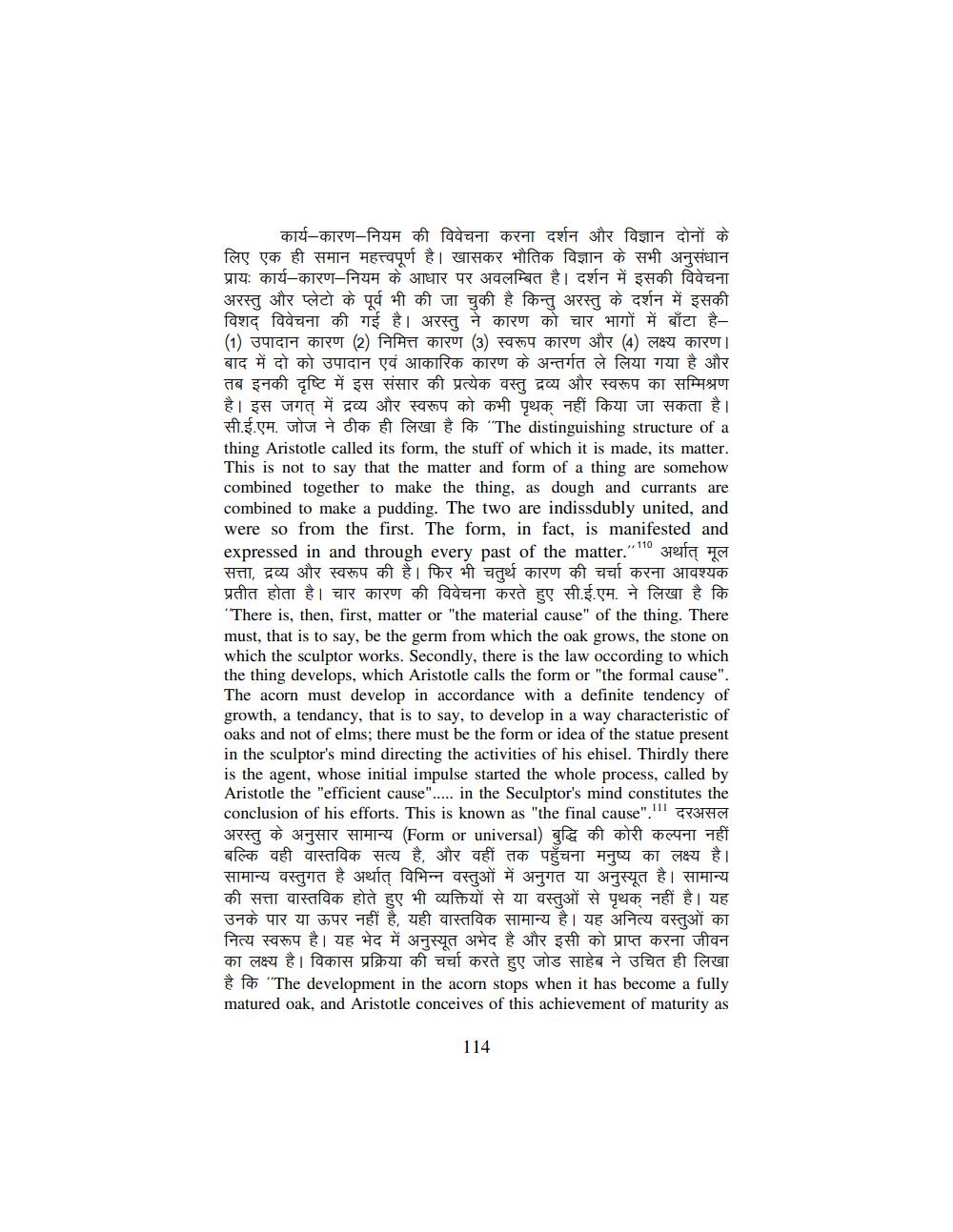________________ कार्य-कारण-नियम की विवेचना करना दर्शन और विज्ञान दोनों के लिए एक ही समान महत्त्वपूर्ण है। खासकर भौतिक विज्ञान के सभी अनुसंधान प्रायः कार्य-कारण-नियम के आधार पर अवलम्बित है। दर्शन में इसकी विवेचना अरस्तु और प्लेटो के पूर्व भी की जा चुकी है किन्तु अरस्तु के दर्शन में इसकी विशद् विवेचना की गई है। अरस्तु ने कारण को चार भागों में बाँटा है(1) उपादान कारण (2) निमित्त कारण (3) स्वरूप कारण और (4) लक्ष्य कारण। बाद में दो को उपादान एवं आकारिक कारण के अन्तर्गत ले लिया गया है और तब इनकी दृष्टि में इस संसार की प्रत्येक वस्तु द्रव्य और स्वरूप का सम्मिश्रण है। इस जगत में द्रव्य और स्वरूप को कभी पृथक नहीं किया जा सकता है। सी.ई.एम. जोज ने ठीक ही लिखा है कि "The distinguishing structure of a thing Aristotle called its form, the stuff of which it is made, its matter. This is not to say that the matter and form of a thing are somehow combined together to make the thing, as dough and currants are combined to make a pudding. The two are indissdubly united, and were so from the first. The form, in fact, is manifested and expressed in and through every past of the matter." 110 37efa Hal सत्ता, द्रव्य और स्वरूप की है। फिर भी चतुर्थ कारण की चर्चा करना आवश्यक प्रतीत होता है। चार कारण की विवेचना करते हुए सी.ई.एम. ने लिखा है कि "There is, then, first, matter or "the material cause" of the thing. There must, that is to say, be the germ from which the oak grows, the stone on which the sculptor works. Secondly, there is the law occording to which the thing develops, which Aristotle calls the form or "the formal cause". The acorn must develop in accordance with a definite tendency of growth, a tendancy, that is to say, to develop in a way characteristic of oaks and not of elms; there must be the form or idea of the statue present in the sculptor's mind directing the activities of his ehisel. Thirdly there is the agent, whose initial impulse started the whole process, called by Aristotle the "efficient cause"..... in the Seculptor's mind constitutes the conclusion of his efforts. This is known as "the final cause"."" दरअसल अरस्तु के अनुसार सामान्य (Form or universal) बुद्धि की कोरी कल्पना नहीं बल्कि वही वास्तविक सत्य है, और वहीं तक पहुँचना मनुष्य का लक्ष्य है। सामान्य वस्तुगत है अर्थात् विभिन्न वस्तुओं में अनुगत या अनुस्यूत है। सामान्य की सत्ता वास्तविक होते हुए भी व्यक्तियों से या वस्तुओं से पृथक् नहीं है। यह उनके पार या ऊपर नहीं है, यही वास्तविक सामान्य है। यह अनित्य वस्तुओं का नित्य स्वरूप है। यह भेद में अनुस्यूत अभेद है और इसी को प्राप्त करना जीवन का लक्ष्य है। विकास प्रक्रिया की चर्चा करते हुए जोड साहेब ने उचित ही लिखा है कि "The development in the acorn stops when it has become a fully matured oak, and Aristotle conceives of this achievement of maturity as 114




